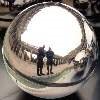I have said
before how much I like maps, and for many years I have been recording our travels in electronic maps of one form or another. I have always been fascinated by maps, and I like plotting-out where we have been, or plotting (in the other sense)where we would like to go. And it suits me to organise information spatially - that's how my brain works.
Ten years ago, this meant nothing more sophisticated than manually drawing routes on a map image using PaintShop, and later using simple (crude even) GIS (geographic information systems) applications. But more recently the advent of the amazing
Google Earth has meant that I can create accurate vector maps over a high quality map/image base, and include all sorts of extra information. I have found this irresistible - compulsive even, to the extent that for
our last canal boat holiday I used Google Earth to produce a map showing all 110 locks we were due to pass through - to within a couple of metres accuracy. The last few times we have been away with friends they have been "treated" to detailed Google Earth files detailing the location of recommended bars and even the best route to walk from the station to the hotel. It is over-the-top I know, but I love doing it. However, I have always struggled to effectively present map information on our web pages, and until very recently I have usually had to resort to simply posting static images and screenshots.
Two fairly recent developments have changed all this. First, the excellent
Google Maps service provided a method of incorporating your own information into their map viewer. This means that I can now display maps and interactive information I have created in Google Maps on a web page in any browser. And now they have introduced a simple way of embedding these interactive maps into any web page (including Blogger). You can see the results in the two examples above and below. These are both segments of our recent trip to north Norway - the first shows our route from Tromsø to the Lofoten islands, and the second is a detailed view of the centre of Tromsø. You can pan and zoom the maps, switch between map and aerial views, and if you click on the icons you will see further information and pictures etc.
It's great - I love it. Expect more!



